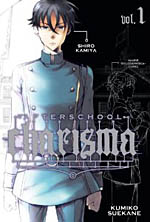 By Kumiko Suekane
By Kumiko Suekane
208 pages, black and white
Published by Viz
The idea behind Afterschool Charisma has a lot of potential: a school populated almost entirely with clones of famous historical figures, being all raised together. Told primarily through the eyes of the one non-clone (Shiro, the son of one of the professors), it offers up a chance to let us see how given a second chance these characters might either end up the same, or radically different. What we actually get, though, is a book that has a couple of great moments but otherwise ends up feeling more like a clone of far too many other manga series out there.
Kumiko Suekane’s opening chapter of Afterschool Charisma has one of the two better ideas of the series, as the clone of Marie Curie finds herself wanting to study music instead of science. It ties into one of the main themes of the series, the idea of trying to live up to all the potential the clones are told they have and how they respond to that pressure. Based on this initial chapter I can see Afterschool Charisma in some ways trying to serve as an analogy for pressures from parents placed on children, not living up to their expectations. Afterwards, though, it feels like Afterschool Charisma manages to ditch a lot of the more interesting aspects of that first chapters and focus on the parts I didn’t like, with the high school cliques and bullies up against our weaker hero.
When Afterschool Charisma dwells more on the famous clones bickering and fighting amongst one another, it’s really no different than just about any bad high school manga. File the names off of the characters and there’s no difference whatsoever. It’s almost surprising how quickly the book starts to lose its way, playing down some of the clone aspects and bringing to the forefront the most unoriginal parts of the book. It does start pulling out of its tailspin about halfway through, though, with the second of the two better ideas of the series: one of the students is an amiable, helpful Hitler. Now, it’s early enough that Suekane could drop this ball (it’s not like we haven’t already seen other balls dropped in Afterschool Charisma), but for now I found myself actually warming to the fact that Suekane is bringing back the idea that some of the clones will try to turn out differently than their genetic counterparts. It’s an extreme choice of character to do so, but then again he’s one of the few historical figures that people would almost all recognize and understand the importance of from history. With any lesser figure, you run the risk of your audience not comprehending why this is someone shunned by the rest of the school.
Suekane’s art is little more than generic, with its exaggerated expressions, wide eyes, and absent backgrounds. I feel bad saying that there’s such a thing as a "typical manga style" because there are so many excellent artists out there that don’t fall into that category. That said, though, there is certainly a house style that a lot of artists in Japan subscribe to, and Suekane is in that group. What startled me, though, was how little Suekane seems to even try to make these clones look like their genetic parents. After all, if they’re clones, shouldn’t they look the same? Most of these characters look just like average students, with little to no reference material being used to make them appear as they should. It’s disappointing, although it would certainly make a transformation of this series into one without mention of clones that much easier.
Every now and then Afterschool Charisma has an interesting idea or two, like a group threatening to assassinate all of the clones, but Suekane seems at times much more interested in typical high school drama. I wanted to like Afterschool Charisma, based not only its concept but because it’s part of the SIGIKKI group that’s turned out some top-notch series like Saturn Apartments, Children of the Sea, and Kingyo Used Books. For now, though, I’m finding it hard to maintain any sort of interest. I’ll check out some more chapters online to see if things improve, but for now, this book itself is too much a bad clone of a bad genetic parent.
Purchase Links: Amazon.com | Powell’s Books
